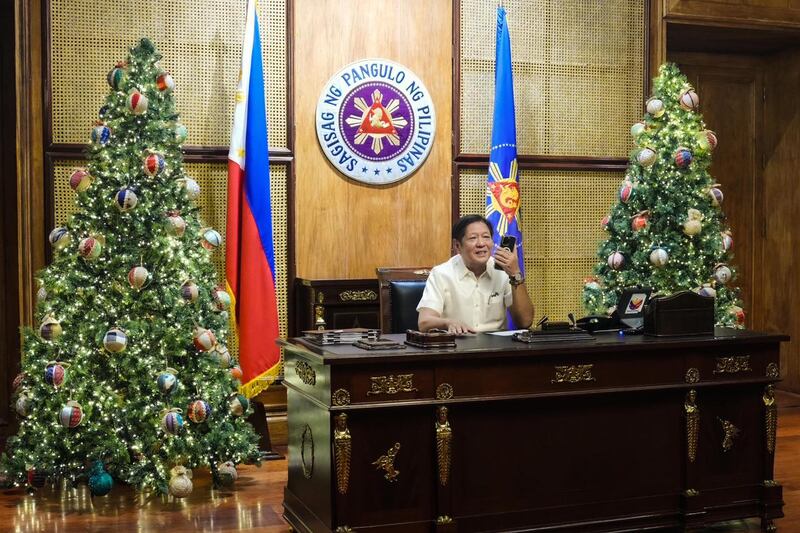The U.S.-Philippines defense alliance remains ironclad, American Defense Secretary Lloyd Austin said while visiting an island on the frontline of Manila's South China Sea dispute with Beijing.
Austin’s visit to Palawan island on Tuesday took place amid increasing tensions between Manila and Beijing over the contested South China Sea.
Reporters at a media conference following the visit asked Austin whether the U.S. under Donald Trump would continue with the same level of bilateral defense relations as the current Joe Biden administration.
Washington is “profoundly committed to the defense” of its Asian ally, Austin said during the news conference with his Philippine counterpart Gilberto Teodoro Jr. at the Philippines’ Western Command headquarters in Puerto Princesa.
“Our commitment to the Mutual Defense Treaty is ironclad,” he said, adding that the treaty applied to coast guards “anywhere in the South China Sea” in addition to ground forces.
Under the 1951 treaty, both nations have to aid each other in the face of a third country attacking one of them.
“I believe that this will remain an important country to us for many, many years in the future. And the strength of our alliance, I think, will transcend changes of administration going forward,” Austin said.
“I won’t speculate on any changes in policy or anything that the new administration may bring on board. What I will tell you is that this is an important country not only to me but to people in both parties back in the United States.”
The United States would continue to help in the Philippine military’s modernization amid the increasing challenges it was facing, the U.S. defense chief said, alluding to China.
Washington condemns Beijing’s “dangerous and escalatory measures” against “lawful Philippine operations” in disputed waters, Austin said.
The U.S. has backed the Philippines against China’s aggressive actions in staking its claim in the South China Sea. Austin underscored his government’s “continued support” to the Philippines’ defense of its “sovereign rights and jurisdiction,” according to a joint statement.
There have been tense standoffs between Manila and Beijing in the South China Sea over the past few months even after both sides in July agreed to dial down tensions.
The dispute has sparked regional jitters that escalating confrontations could spark a shooting war in the waterway, which the various claimants have been trying to avoid.
Austin was visiting the Philippines for the fourth time since he took office, making him the U.S. defense chief who has visited the Southeast Asian country the most.
He was the second-highest American official ever to have visited Puerto Princesa city, the capital of Palawan province.
U.S. Vice President Kamala Harris visited Palawan in November 2022, where she criticized Beijing for its alleged coercive tactics in the South China Sea and reiterated Washington's full military support for Manila.
RELATED STORIES
[ US election: Trump II to affect trade, security in SE Asia, experts sayOpens in new window ]
[ Philippine military chief requests longer deployment for US missile systemOpens in new window ]
[ Philippines joins US-led allies in multilateral maneuvers in South China SeaOpens in new window ]
[ US not seeking to create ‘Asian NATO,’ defense secretary saysOpens in new window ]
For his part, Teodoro thanked Austin for the expression of support amid what he said was repeated aggression by Beijing in the West Philippine Sea, which is Manila’s name for South China Sea waters within its exclusive economic zone.
“They have really placed a lot of these pseudo-military vessels disguised as coast guard vessels and maritime militia vessels in the areas of the West Philippine Sea,” Teodoro said.
“They have been very aggressive in their information [campaigns] against the Philippines.”
Austin and Teodoro had on Monday signed an agreement establishing a framework for the exchange of classified military information and defense technology.
The pact is called the General Security of Military Information Agreement (GSOMIA), according to a joint statement issued by both nations.
Neither country has released details about the agreement or provided journalists a copy of it.
In response to the latest agreement, Beijing on Monday said no military deal should “undermine regional peace or exacerbate regional tensions.”
"The only right choice for safeguarding national security and regional peace and stability is to uphold good neighborliness and friendship and maintain strategic independence," said Beijing's foreign ministry spokesman Lin Jian.
He further said that any defense or security deal should not target a third party or its interests.
Marcos-Trump call
Separately, Philippine President Ferdinand Marcos Jr. said he had called U.S. President-elect Donald Trump on Tuesday to congratulate him for his recent election victory.
"And I expressed to him our continuing desire to strengthen that relationship between our two countries, which is a relationship that is as deep as can possibly be," said Marcos.

Since assuming the presidency in 2022, Marcos has done a U-turn from his predecessor Rodrigo Duterte on Manila’s position towards the U.S. and China and over the South China Sea issue.
Duterte was seen as friendlier toward China.
And under Marcos, the Philippines has allowed the U.S. expanded access to its military bases. Last year, Marcos made the official visit first by a Philippine leader to the United States in more than a decade.
The U.S. in turn has for the first time in the Asia-Pacific region deployed its mid-range missile Typhon system in the Philippines as part of a joint military exercise.
This has angered rival superpower China, which called the move “destabilizing” to regional peace.
